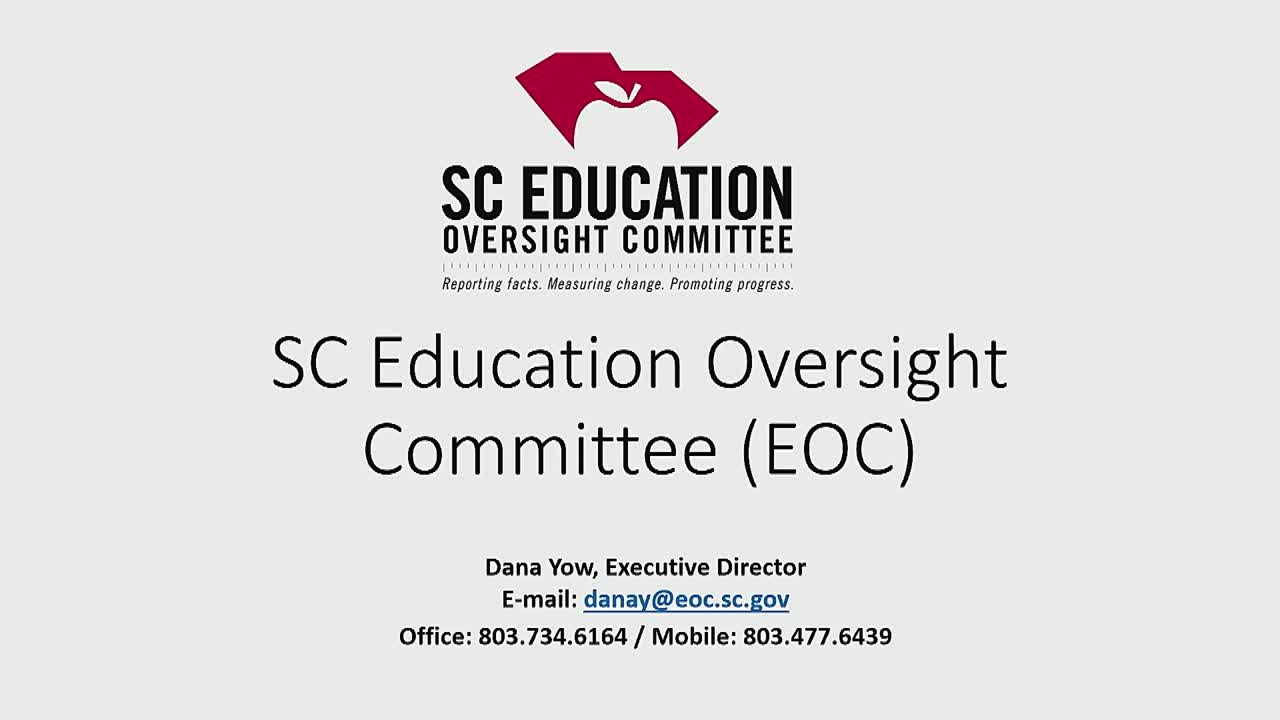Education Oversight Committee: 85.4% on-time graduation in 2024; members press on readiness and absenteeism
April 30, 2025 | 2025 Legislative Meetings, South Carolina
This article was created by AI summarizing key points discussed. AI makes mistakes, so for full details and context, please refer to the video of the full meeting. Please report any errors so we can fix them. Report an error »

The Education Oversight Committee reported to the House Education and Public Works Committee that 85.4% of South Carolina public high school students graduated on time in 2024, while committee members pressed the agency about college- and career-readiness and rising chronic absenteeism.
The EOC, which approves content standards and statewide assessments and issues the annual school report cards, presented its role, data dashboard and recent evaluations. "The evaluations that we've done show that that program does work for 4 year olds," EOC Executive Director Dana Yao said, referring to the full‑day 4K program funded by the General Assembly.
Yao described the EOC's work approving standards in English language arts, math, science and social studies for accountability, producing an education data dashboard at dashboardsc.sc.gov, and conducting evaluations of state‑funded programs. She told members the committee annually evaluates programs including full‑day 4K, the Educational Credit for Exceptional Needs program, the teacher loan program and supports for military‑connected students.
Committee members focused on outcomes and next steps. Mr. Bridal, a committee member, asked what the state should change after hearing that 85.4% of students graduated on time and expressing concern about how many of those graduates are college- or career-ready. Yao and members discussed measures used for college and career readiness — including ACT/SAT thresholds, advanced coursework and industry certifications — and noted multiple readiness measures exist rather than a single pass/fail cutoff.
Yao highlighted other EOC work that may affect outcomes: a rural recruitment evaluation tied to $7,600,000 in Education Improvement Act (EIA) funds for incentives in rural districts, development of a preK dashboard, and studies of alternative modes of instruction (face‑to‑face vs. online/hybrid). She said the EOC is preparing another rural recruitment study in 2026 and that the current evaluation shows some incentives—housing, mentoring, recruitment fairs—are more used than others.
On chronic absenteeism, Yao said the EOC has been convening student focus groups and recently completed parent focus groups; she characterized chronic absence as students missing roughly 10% of the school year and said parent feedback is still being analyzed. She also said the EOC has recommended a public awareness campaign about attendance and noted absenteeism is a national trend.
Members asked for more data and follow-up. Several asked for copies of the slides and dashboard details; Yao said she would share the materials. The EOC noted it operates with a small staff (about eight full‑time equivalents) and produces the cyclical review of the accountability system done periodically by the committee.
The presentation generated requests for more granular data on teacher turnover in rural districts, the effectiveness (return on investment) of specific recruitment incentives, and the results of completed parent focus groups on absenteeism. Yao said the EOC can provide those details on request.
The committee did not take formal votes during the presentation; members directed staff to follow up with requested data and slides.
The EOC, which approves content standards and statewide assessments and issues the annual school report cards, presented its role, data dashboard and recent evaluations. "The evaluations that we've done show that that program does work for 4 year olds," EOC Executive Director Dana Yao said, referring to the full‑day 4K program funded by the General Assembly.
Yao described the EOC's work approving standards in English language arts, math, science and social studies for accountability, producing an education data dashboard at dashboardsc.sc.gov, and conducting evaluations of state‑funded programs. She told members the committee annually evaluates programs including full‑day 4K, the Educational Credit for Exceptional Needs program, the teacher loan program and supports for military‑connected students.
Committee members focused on outcomes and next steps. Mr. Bridal, a committee member, asked what the state should change after hearing that 85.4% of students graduated on time and expressing concern about how many of those graduates are college- or career-ready. Yao and members discussed measures used for college and career readiness — including ACT/SAT thresholds, advanced coursework and industry certifications — and noted multiple readiness measures exist rather than a single pass/fail cutoff.
Yao highlighted other EOC work that may affect outcomes: a rural recruitment evaluation tied to $7,600,000 in Education Improvement Act (EIA) funds for incentives in rural districts, development of a preK dashboard, and studies of alternative modes of instruction (face‑to‑face vs. online/hybrid). She said the EOC is preparing another rural recruitment study in 2026 and that the current evaluation shows some incentives—housing, mentoring, recruitment fairs—are more used than others.
On chronic absenteeism, Yao said the EOC has been convening student focus groups and recently completed parent focus groups; she characterized chronic absence as students missing roughly 10% of the school year and said parent feedback is still being analyzed. She also said the EOC has recommended a public awareness campaign about attendance and noted absenteeism is a national trend.
Members asked for more data and follow-up. Several asked for copies of the slides and dashboard details; Yao said she would share the materials. The EOC noted it operates with a small staff (about eight full‑time equivalents) and produces the cyclical review of the accountability system done periodically by the committee.
The presentation generated requests for more granular data on teacher turnover in rural districts, the effectiveness (return on investment) of specific recruitment incentives, and the results of completed parent focus groups on absenteeism. Yao said the EOC can provide those details on request.
The committee did not take formal votes during the presentation; members directed staff to follow up with requested data and slides.
View full meeting
This article is based on a recent meeting—watch the full video and explore the complete transcript for deeper insights into the discussion.
View full meeting